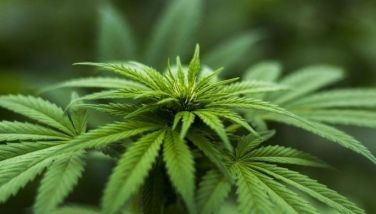Cassava foliage good as carabao feed – study
June 15, 2003 | 12:00am
Cassava foliage (CSF), when detoxified, is good as animal feed.
As has been scientifically established, cassava has a toxic hydrocyanic acid (HCN), which has been limiting its use in animal feeding.
Earlier studies had focused on the use of cassava tuber (root) as carbohydrate food source by humans, as animal feed, and for other industrial purposes. It has been reported that chopping, followed by sun-drying, can effectively detoxify the tubers.
However, cassava foliage as animal feed has not been fully studied, prompting the PCC in Ubay, Bohol, to conduct a research titled "Processing of cassava (Manhiot esculenta) foliage as feed for water buffalo."
The researchers – C.B. Salces, B.A. Hingpit, D.B. Roxas, U.M. Lustria, S.S. Capitan, I.M. Pabuayon, and F.E. Merca – evaluated the biological and economic potentials of CSF processing and utilization as feed for carabao.
Analysis, as reported by the DA-Bureau of Agricultural Research (BAR), showed that fresh CSF contained HCN ranging from 86 to 186 parts per million (ppm) (fresh basis).
Wilting or drying reduced the HCN content below biologically acceptable level of 80 ppm (dry basis) for low and medium HCN varieties but not for high HCN varieties, which was reduced only by ensiling (storing in a silo).
Buffaloes fed with different levels of ensiled CSF showed average daily gain increase from 0.74 kilograms in the control animals (0 percent CSF) to 0.86 kg in the experimental animals (50 percent CSF in roughage).
Income increased from P15,360 in cassava without defoliation to P22,160 in cassava with defoliation and P36,775 for cassava with livestock integration, the researchers reported. – RAF
As has been scientifically established, cassava has a toxic hydrocyanic acid (HCN), which has been limiting its use in animal feeding.
Earlier studies had focused on the use of cassava tuber (root) as carbohydrate food source by humans, as animal feed, and for other industrial purposes. It has been reported that chopping, followed by sun-drying, can effectively detoxify the tubers.
However, cassava foliage as animal feed has not been fully studied, prompting the PCC in Ubay, Bohol, to conduct a research titled "Processing of cassava (Manhiot esculenta) foliage as feed for water buffalo."
The researchers – C.B. Salces, B.A. Hingpit, D.B. Roxas, U.M. Lustria, S.S. Capitan, I.M. Pabuayon, and F.E. Merca – evaluated the biological and economic potentials of CSF processing and utilization as feed for carabao.
Analysis, as reported by the DA-Bureau of Agricultural Research (BAR), showed that fresh CSF contained HCN ranging from 86 to 186 parts per million (ppm) (fresh basis).
Wilting or drying reduced the HCN content below biologically acceptable level of 80 ppm (dry basis) for low and medium HCN varieties but not for high HCN varieties, which was reduced only by ensiling (storing in a silo).
Buffaloes fed with different levels of ensiled CSF showed average daily gain increase from 0.74 kilograms in the control animals (0 percent CSF) to 0.86 kg in the experimental animals (50 percent CSF in roughage).
Income increased from P15,360 in cassava without defoliation to P22,160 in cassava with defoliation and P36,775 for cassava with livestock integration, the researchers reported. – RAF
BrandSpace Articles
<
>
- Latest
Latest
Latest
April 10, 2024 - 5:12pm
By Ian Laqui | April 10, 2024 - 5:12pm
March 4, 2024 - 3:32pm
By Ian Laqui | March 4, 2024 - 3:32pm
March 4, 2024 - 2:12pm
By Kristine Daguno-Bersamina | March 4, 2024 - 2:12pm
February 17, 2024 - 2:31pm
February 17, 2024 - 2:31pm
February 13, 2024 - 7:24pm
By Gaea Katreena Cabico | February 13, 2024 - 7:24pm
Recommended
January 7, 2025 - 12:00am


























